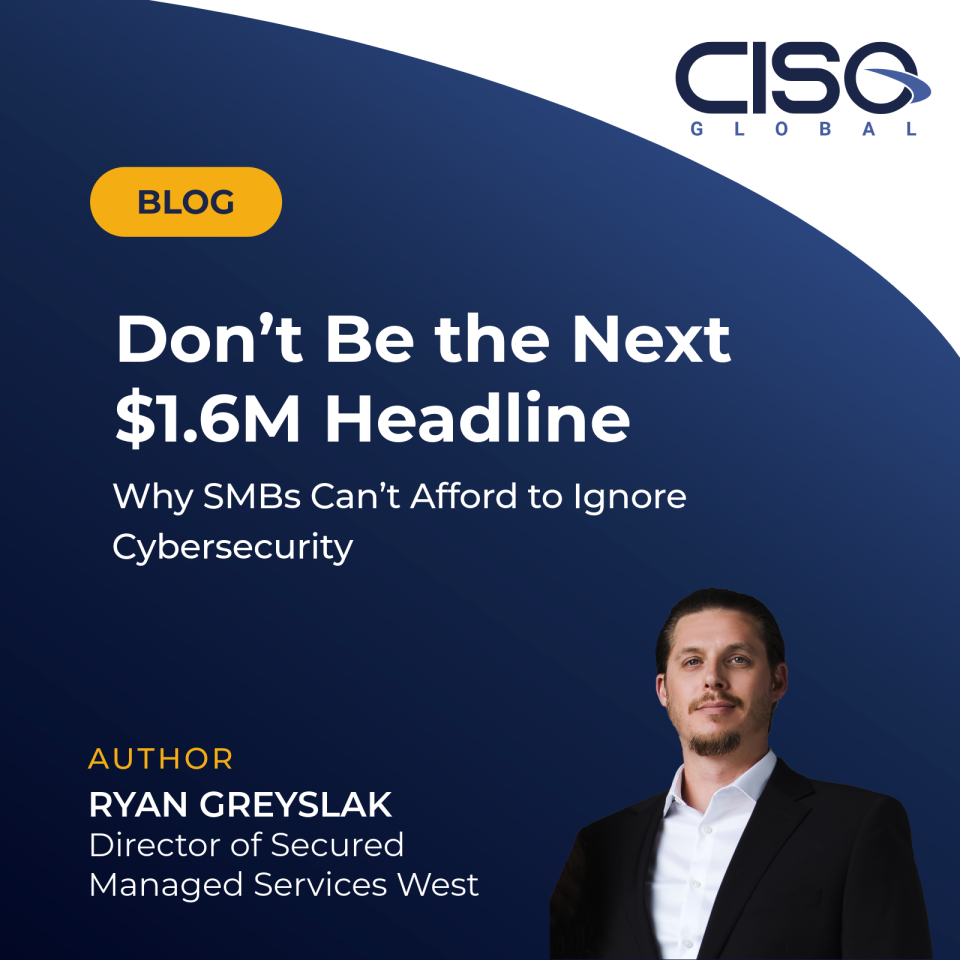Don’t Be the Next $1.6M Headline: Why SMBs Can’t Afford to Ignore Cybersecurity
Ryan Greyslak, Director of Secured Managed Services West

There’s a significant gap between what many SMBs think they’re doing to protect themselves and what it actually takes. Good intentions are not enough. Hope is not a strategy.
Small and midsize businesses, or SMBs, have long believed that they can avoid becoming targets. “We’re not big enough,” they say. “We’re not interesting enough,” they reason. “There are larger companies out there with deeper pockets,” they hope. Unfortunately, attackers don’t share that logic.
Phishing attacks now cost SMBs an average of $1.6 million per incident. That is not a typo. It’s a number big enough to put a business under. And it’s just one type of attack. The average cost of a data breach, according to IBM’s latest Cost of a Data Breach report, sits at $4.88 million globally. That’s not just painful, it’s catastrophic for many SMBs.
The idea that you can “fly under the radar” no longer applies. Every business connected to the internet is visible to threat actors. Criminals don’t need you to be famous, profitable, or high profile. They just need you to be connected and unprepared. And for many organizations, one well-crafted phishing email is all it takes to shift your business from operating mode into emergency mode.
The old analogy about not needing to outrun the bear, just needing to outrun the other hikers, falls apart in cybersecurity. The bear has drones, thermal vision, and is tracking your IP space and probing your endpoints. And if you don’t see the attacks, it’s not because they’re not happening. It’s because you’re not detecting them.
What Are You Actually Doing to Stay Safe?
There’s a significant gap between what many SMBs think they’re doing to protect themselves and what it actually takes. Good intentions are not enough. Hope is not a strategy.
Here are some of the critical components that every business must consider if they expect to survive today’s threat landscape:
- Modern Endpoint Security: Traditional antivirus doesn’t cut it. Today’s threats are dynamic, and your defenses need to include behavior-based detection, threat intelligence, and rapid response capabilities. Endpoint detection and response products, like CISO’s CHECKLIGHT®, are a simple and cost-effective way to add that extra layer of protection.
- Updated Email Security: Phishing remains the single most common entry point for attackers. Relying solely on built-in filters is not enough. Advanced email security platforms can help catch malicious links, impersonation attempts, and payloads before they reach your users.
- Employee Education and Phishing Simulation: Your employees are your first and last line of defense. Regular awareness training, supported by realistic phishing simulations, gives your staff a safe place to learn and practice good habits.
- Offline, Immutable Backups: Ransomware can and will target backups if they are connected to your environment. Disconnected, secure, and immutable backups are essential for recovery and business continuity. My colleague James has written extensively on the subject if you want to learn more.
- Incident Response Planning and Retainers: If something does go wrong (and eventually it will) having a clear, tested plan is critical. Partnering with a cybersecurity team that knows your environment, can respond immediately, and is already on retainer can be the difference between containment and chaos.
The Cost of Doing Nothing
Many SMBs assume it won’t happen to them, but that’s a bet they cannot afford to lose. For a growing number of businesses, a single attack brings operations to a halt. The cost goes far beyond the ransom payment. Consider the interruption to your business, the time spent recovering systems, legal and regulatory obligations, forensic investigations, reputational damage, and lost trust. Some businesses never recover. Others spend months digging out of a hole they didn’t even realize they were vulnerable to.
A Proactive Investment, Not a Reactive Expense
The most expensive way to deal with an incident is to be unprepared. Building your defenses before an attack happens is always more cost-effective than responding to one after it’s underway. Investing in cybersecurity is not a luxury or a nice-to-have. It is essential infrastructure, just like accounting, insurance, or legal support. Threat actors don’t take breaks. They don’t care about the size of your business or how hard you’ve worked. They care about access, data, and money. And if you’re online, you are part of their attack surface.
How CISO Global Can Help
At CISO Global, we partner with businesses of all sizes to bring enterprise-grade cybersecurity to organizations that cannot afford to go without. We provide:
- A full suite of IT and cybersecurity solutions
- 24/7 monitoring and response
- Incident response plans and team retainers
- Phishing training and simulation campaigns
- Secure backup and recovery solutions
- Regular security assessments and roadmap development
Our goal is to make cybersecurity not just accessible, but actionable. You don’t need to build the expertise in-house or figure it out on your own. We bring the team, the technology, and the experience to help you defend your business, meet your compliance requirements, and stay focused on what matters most: your clients and your mission. Because once the attack begins, it’s too late to start planning.